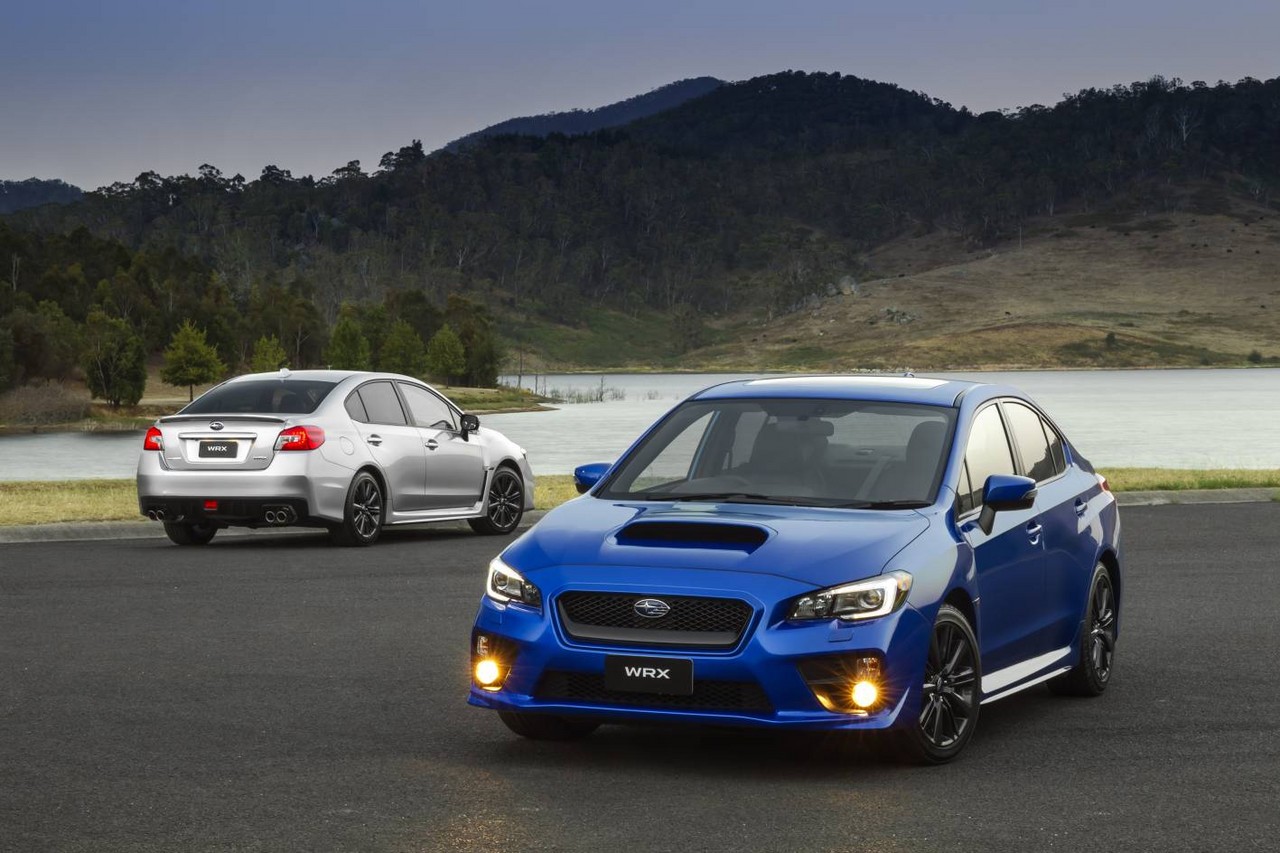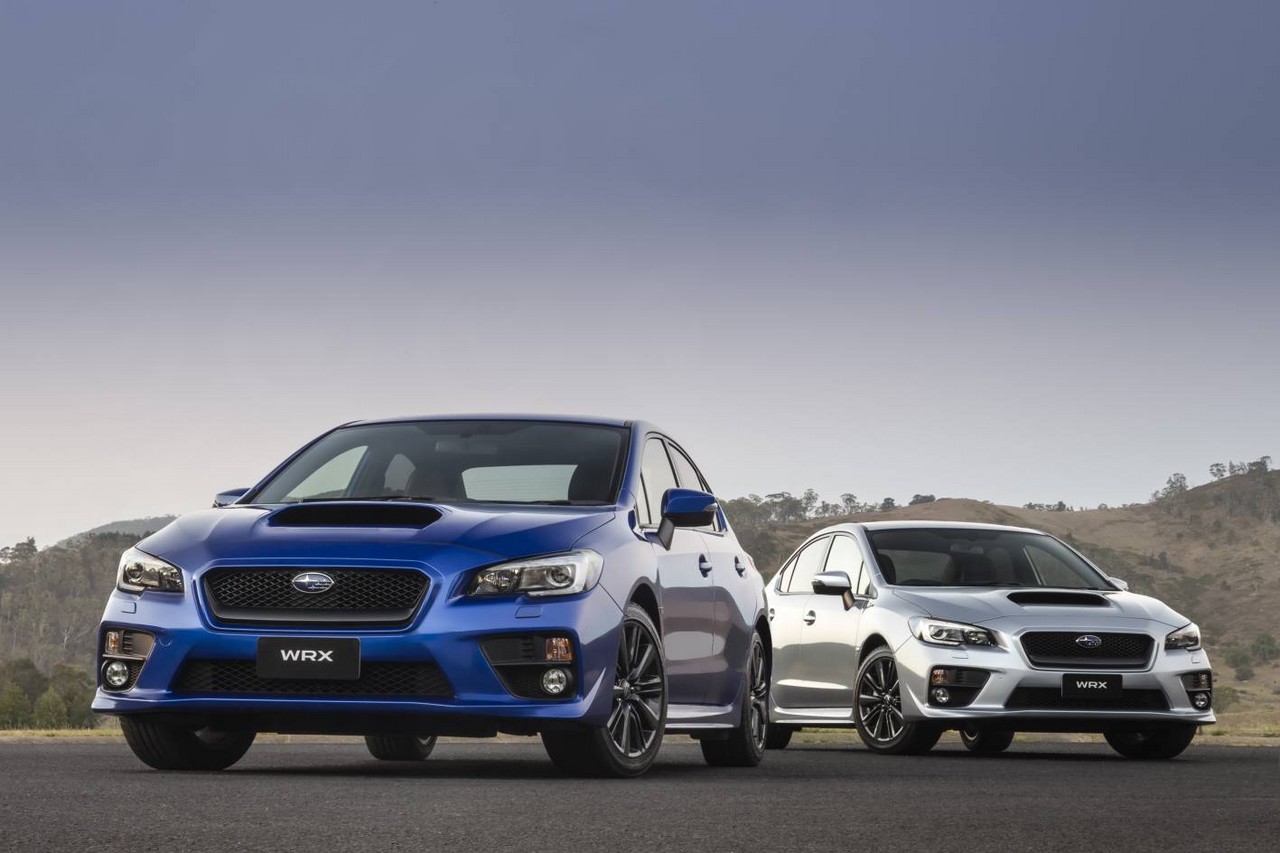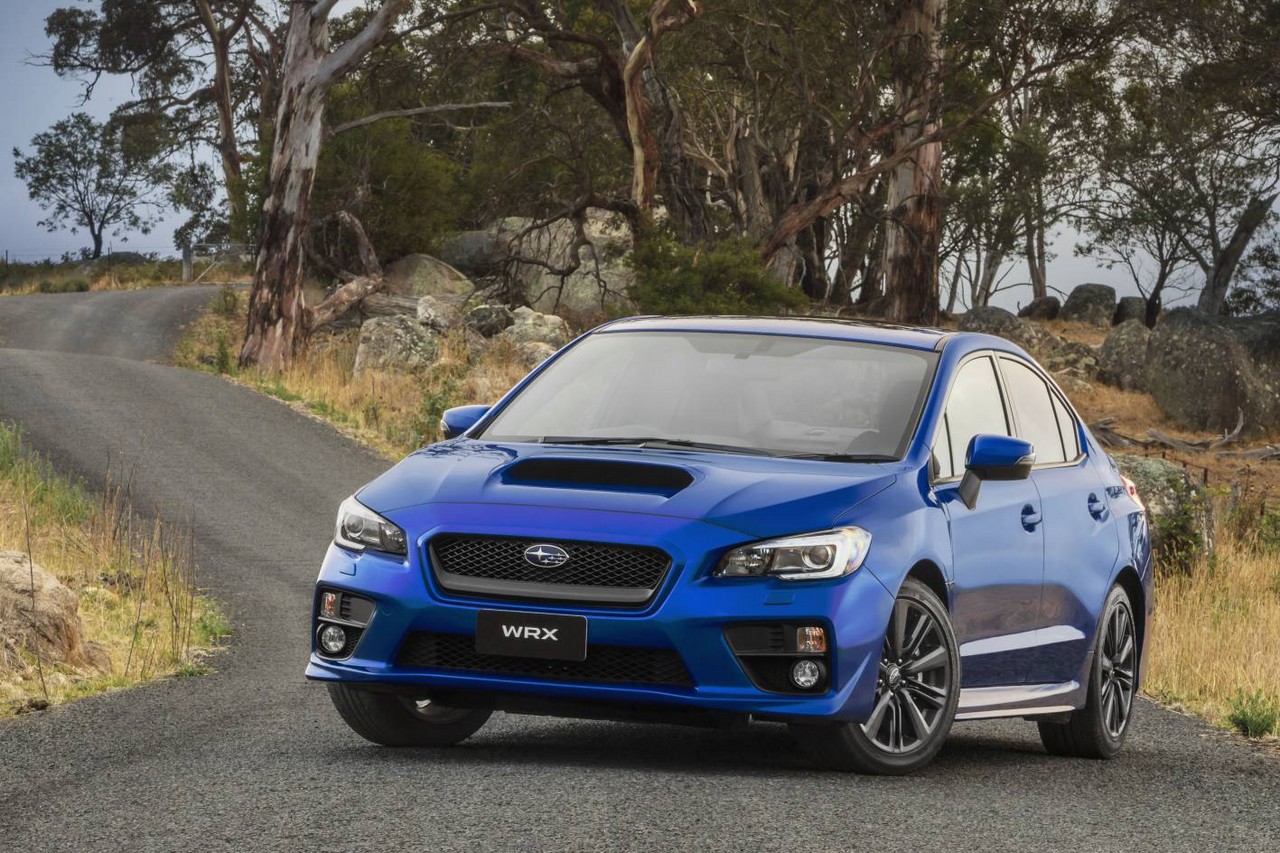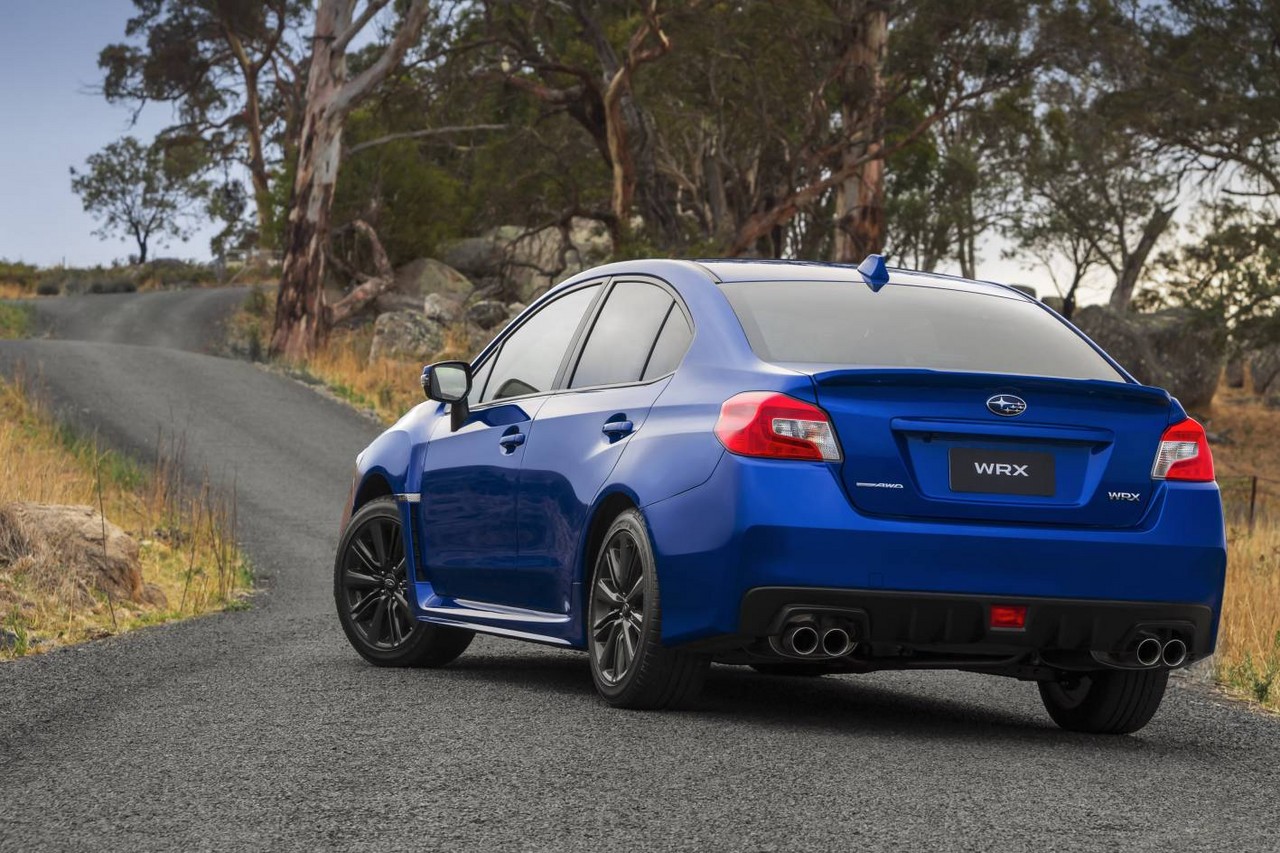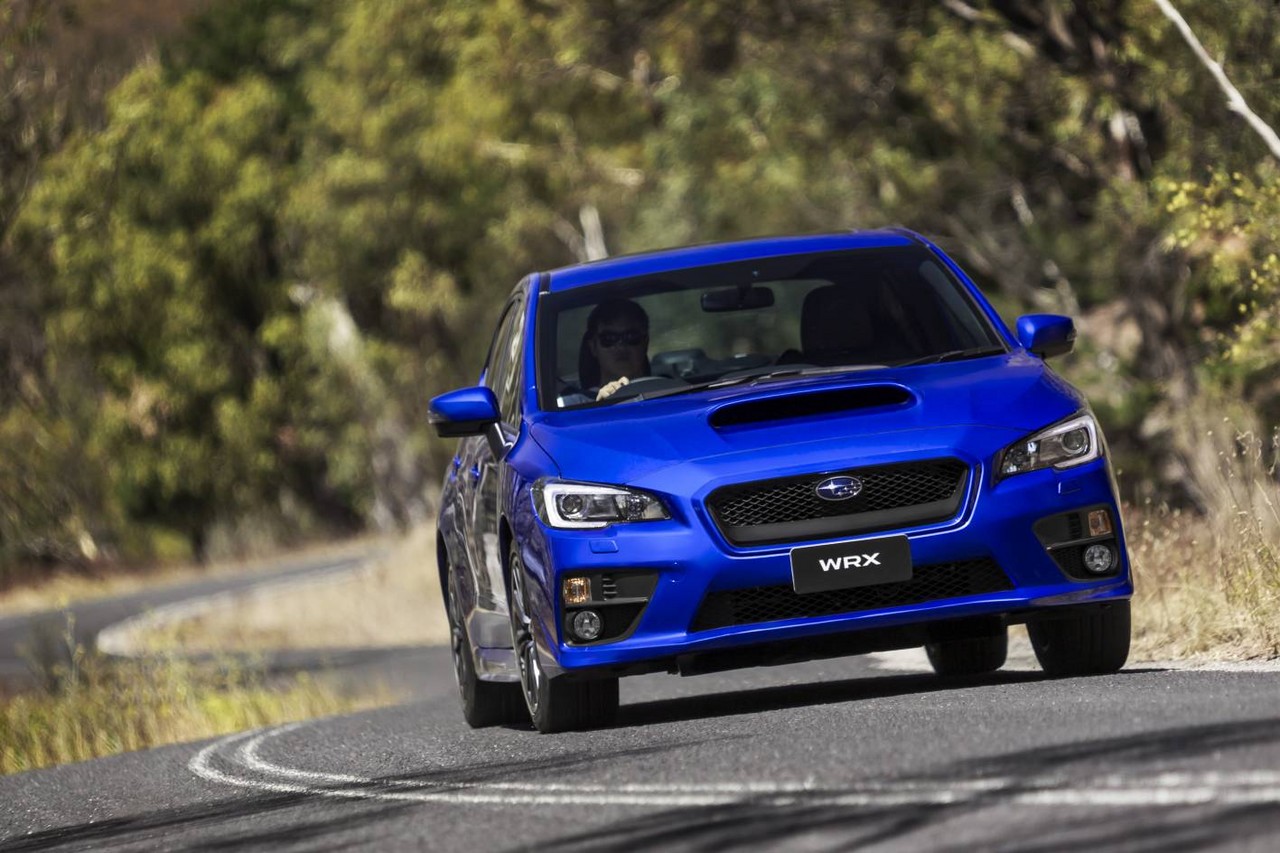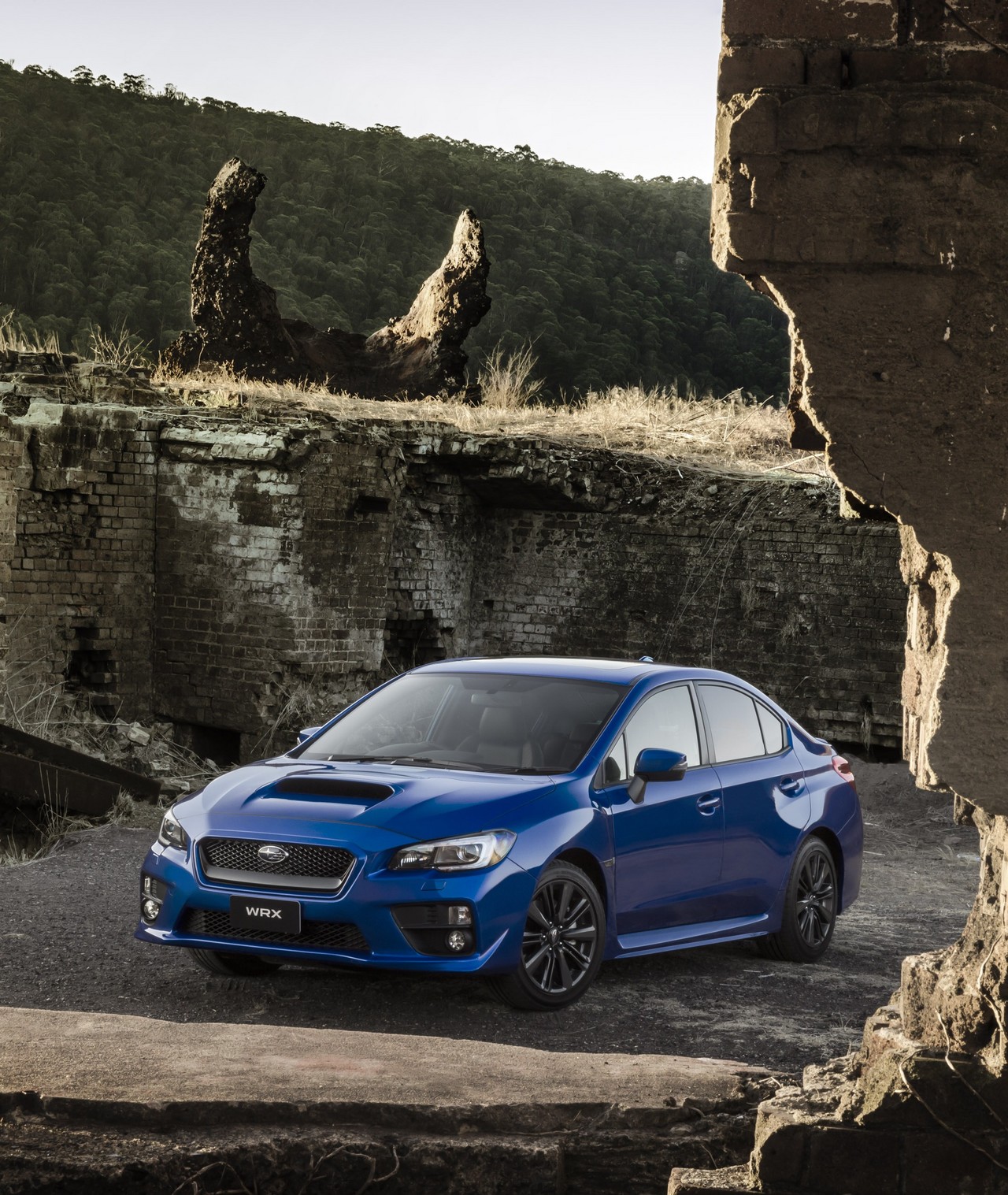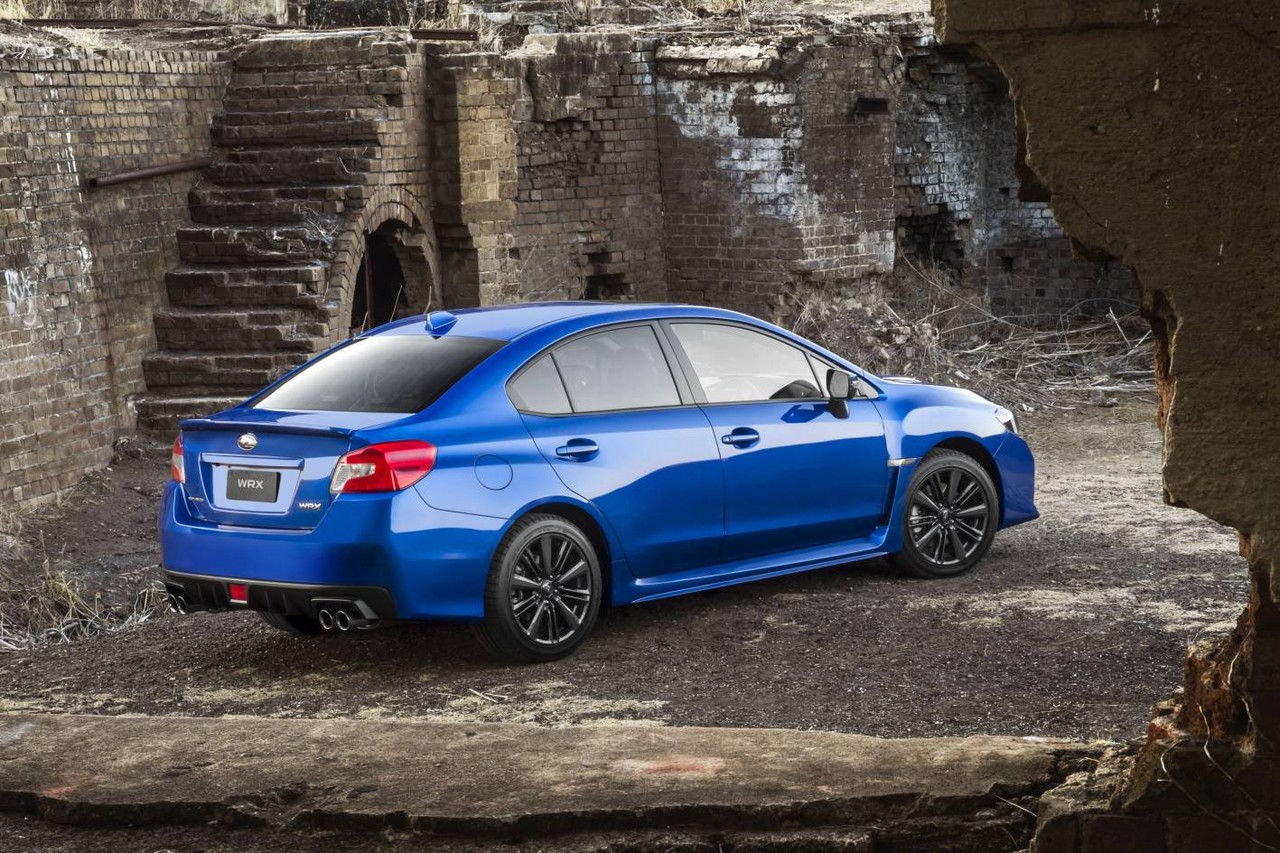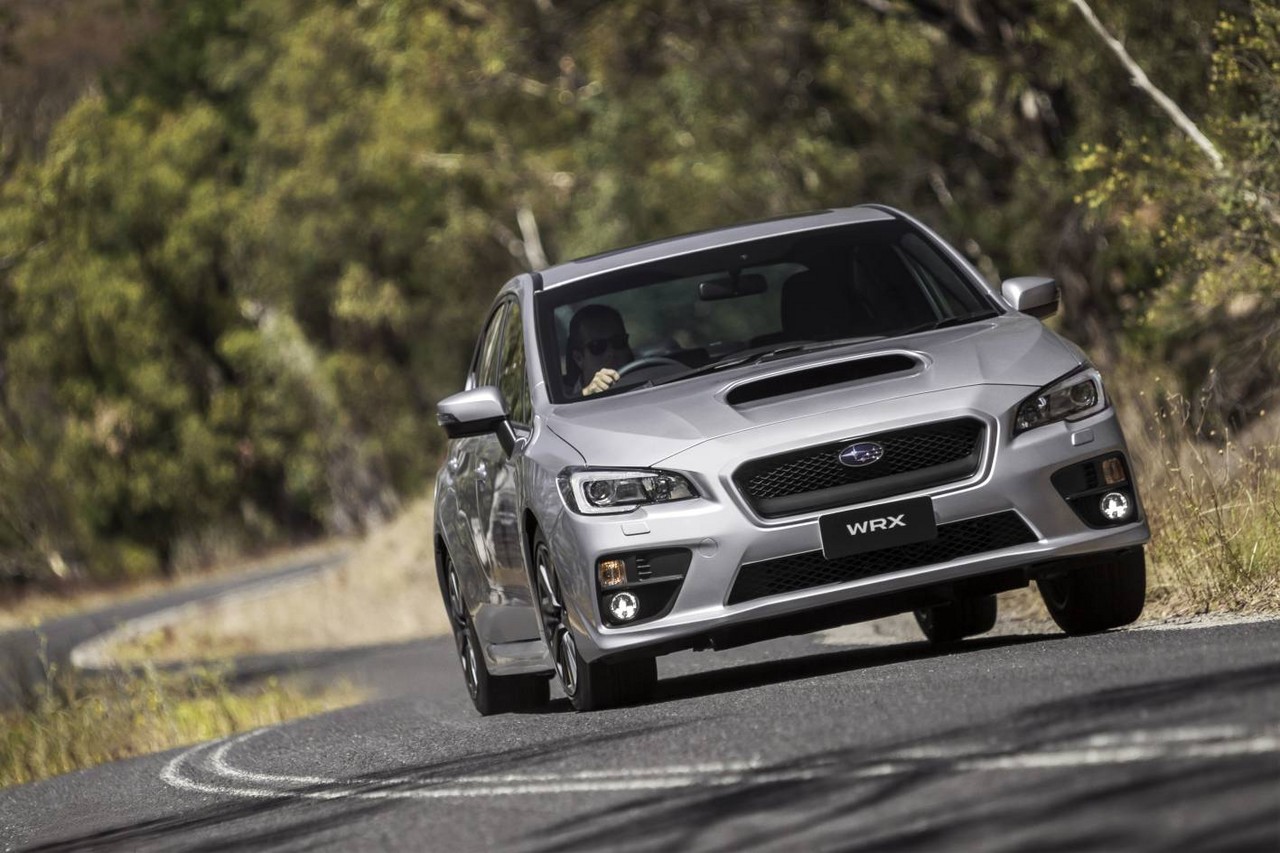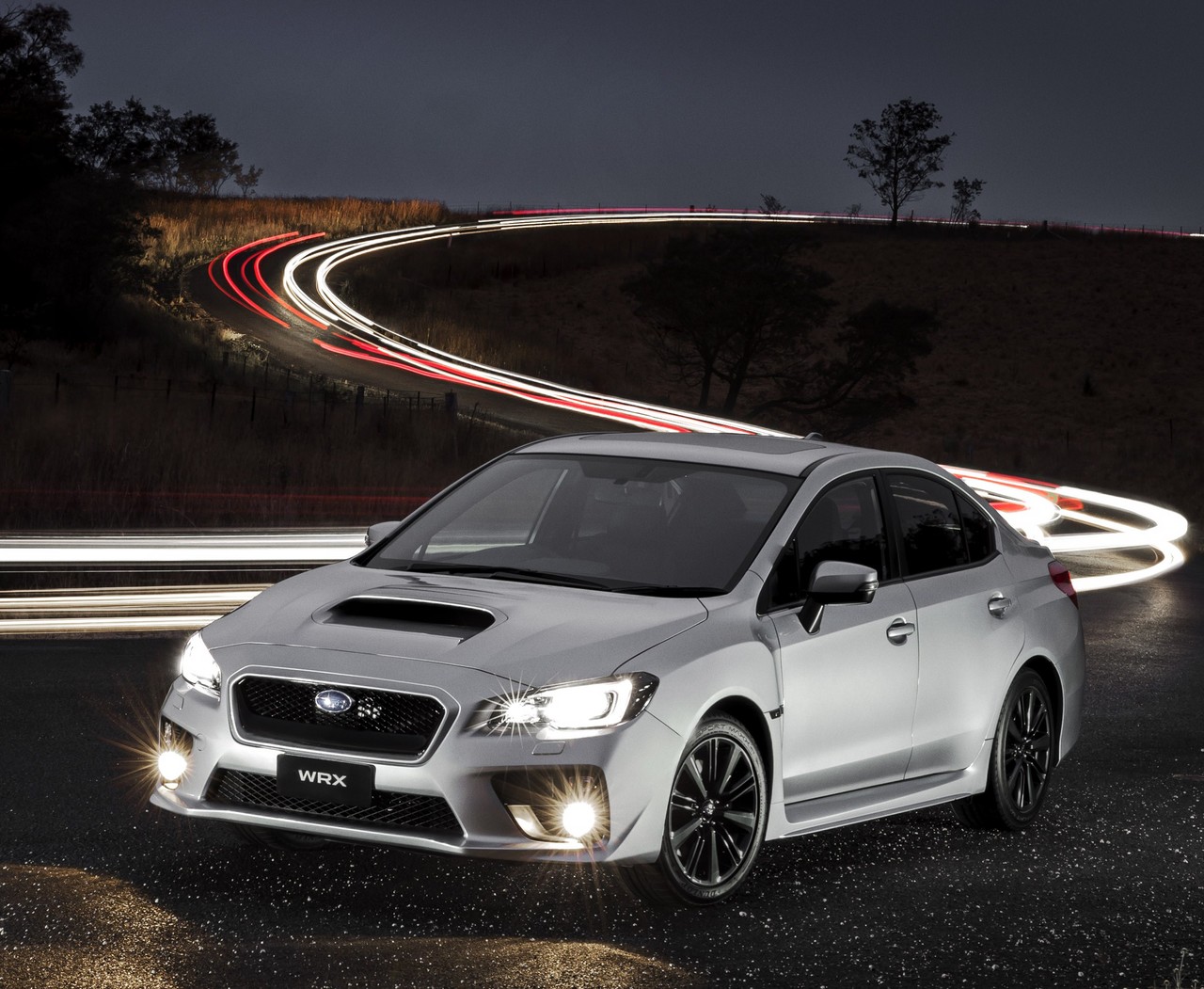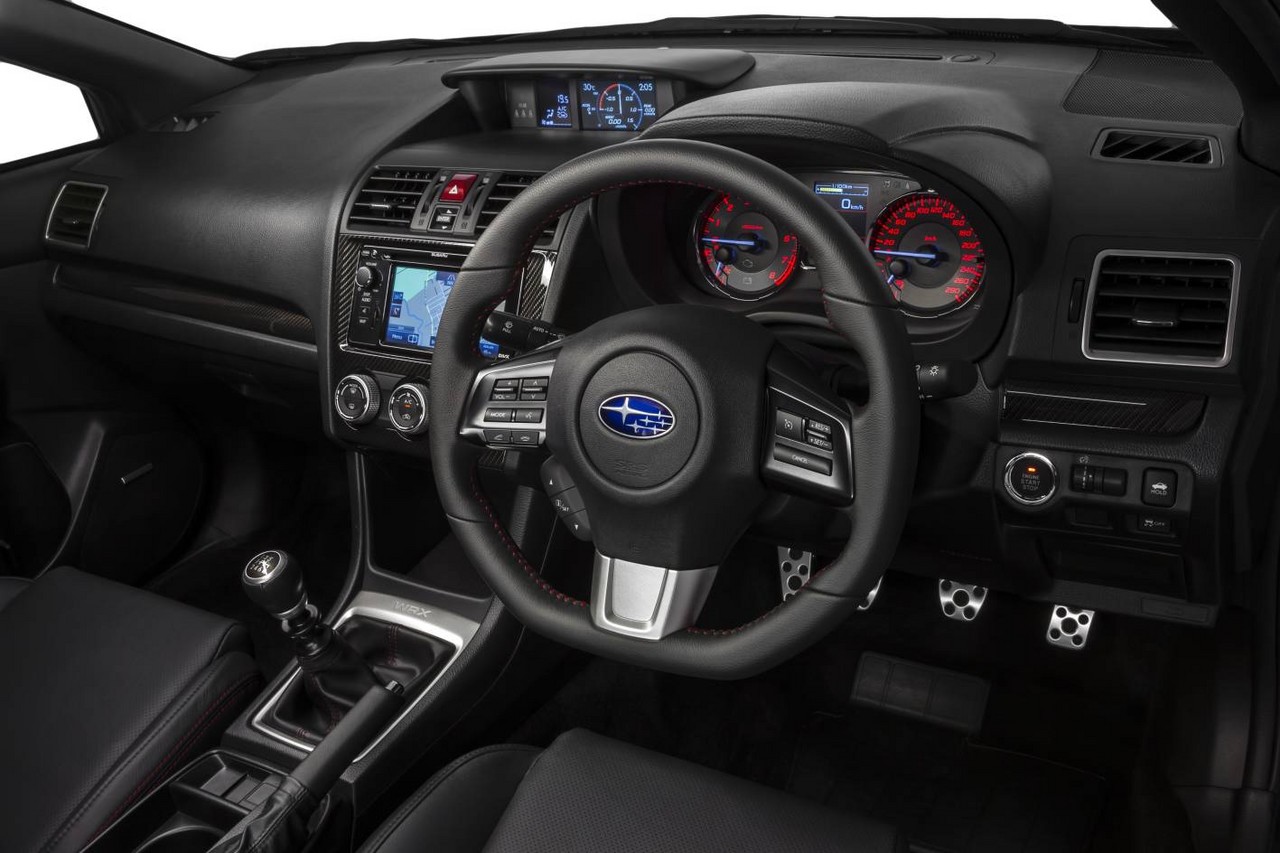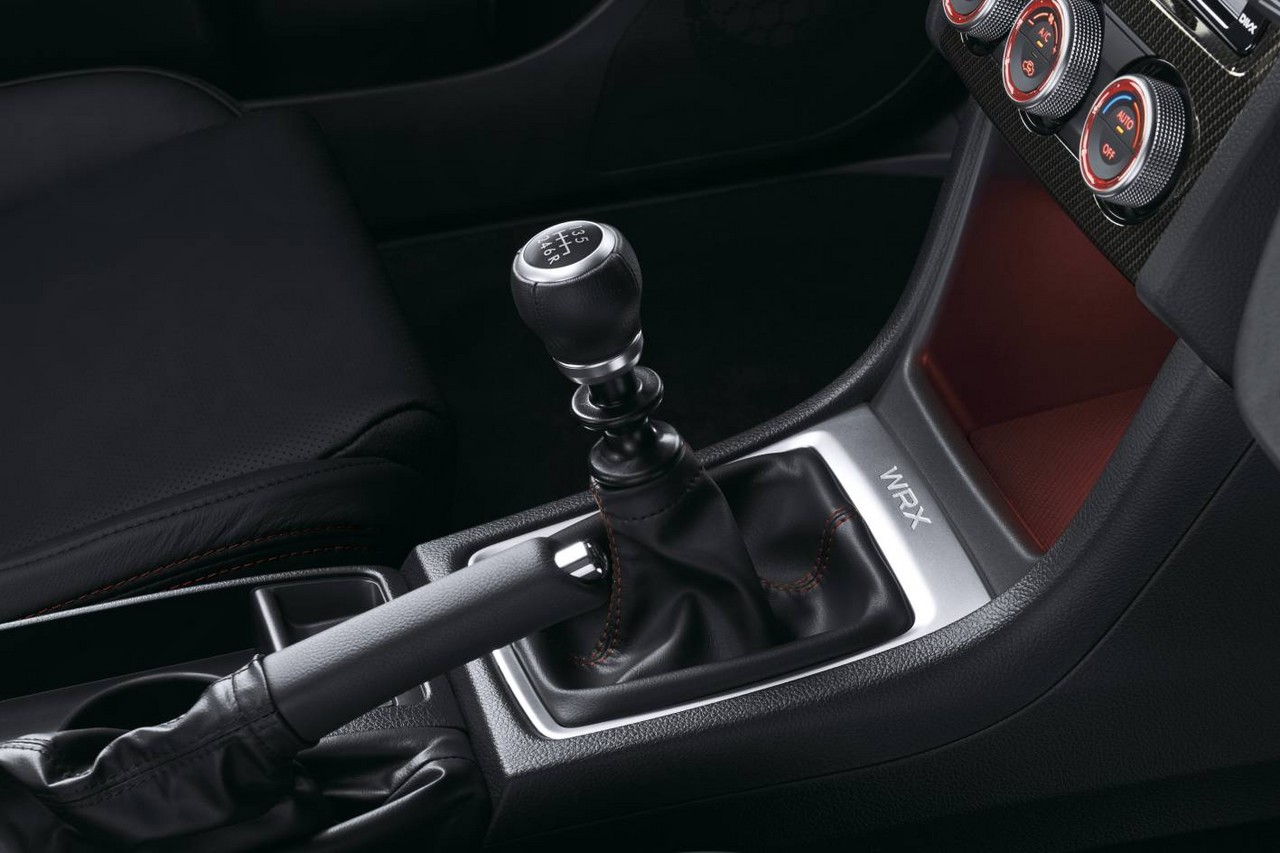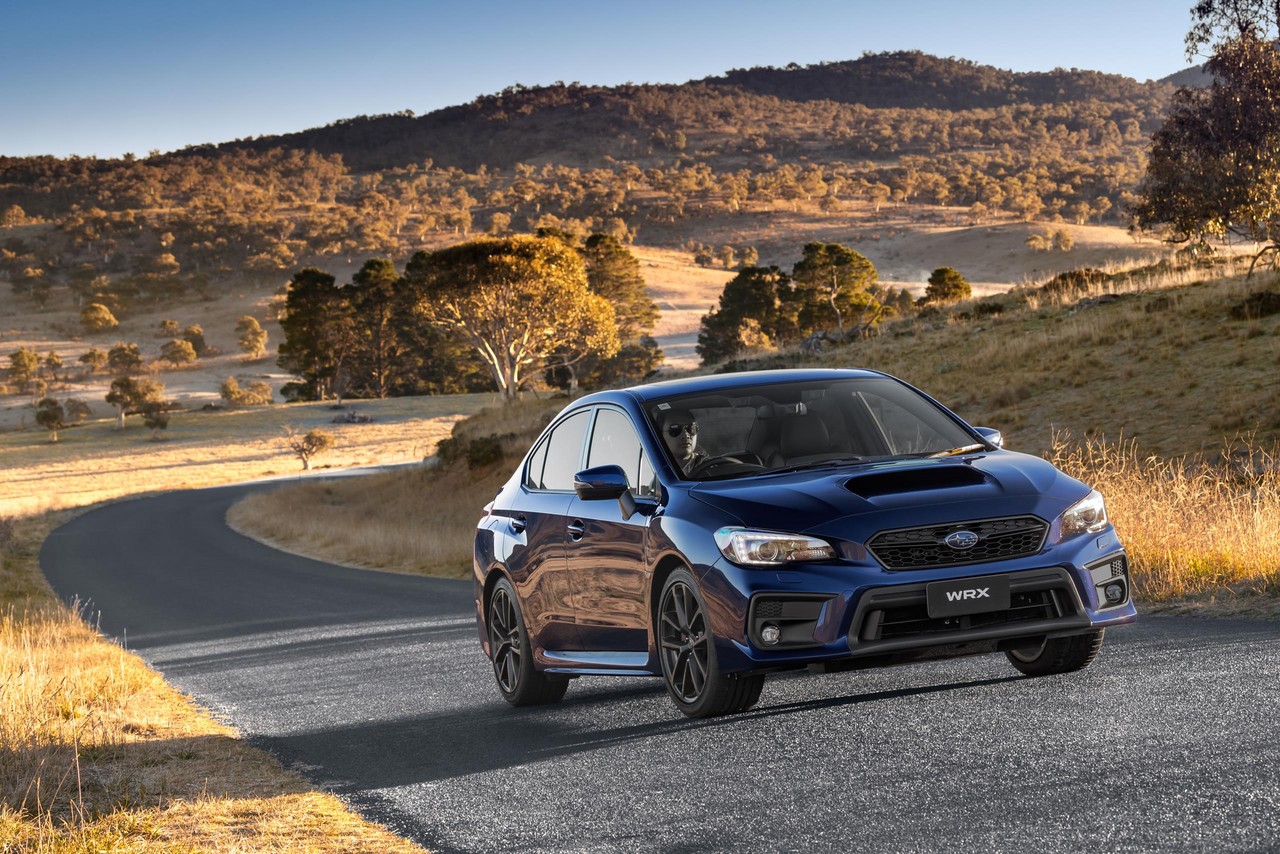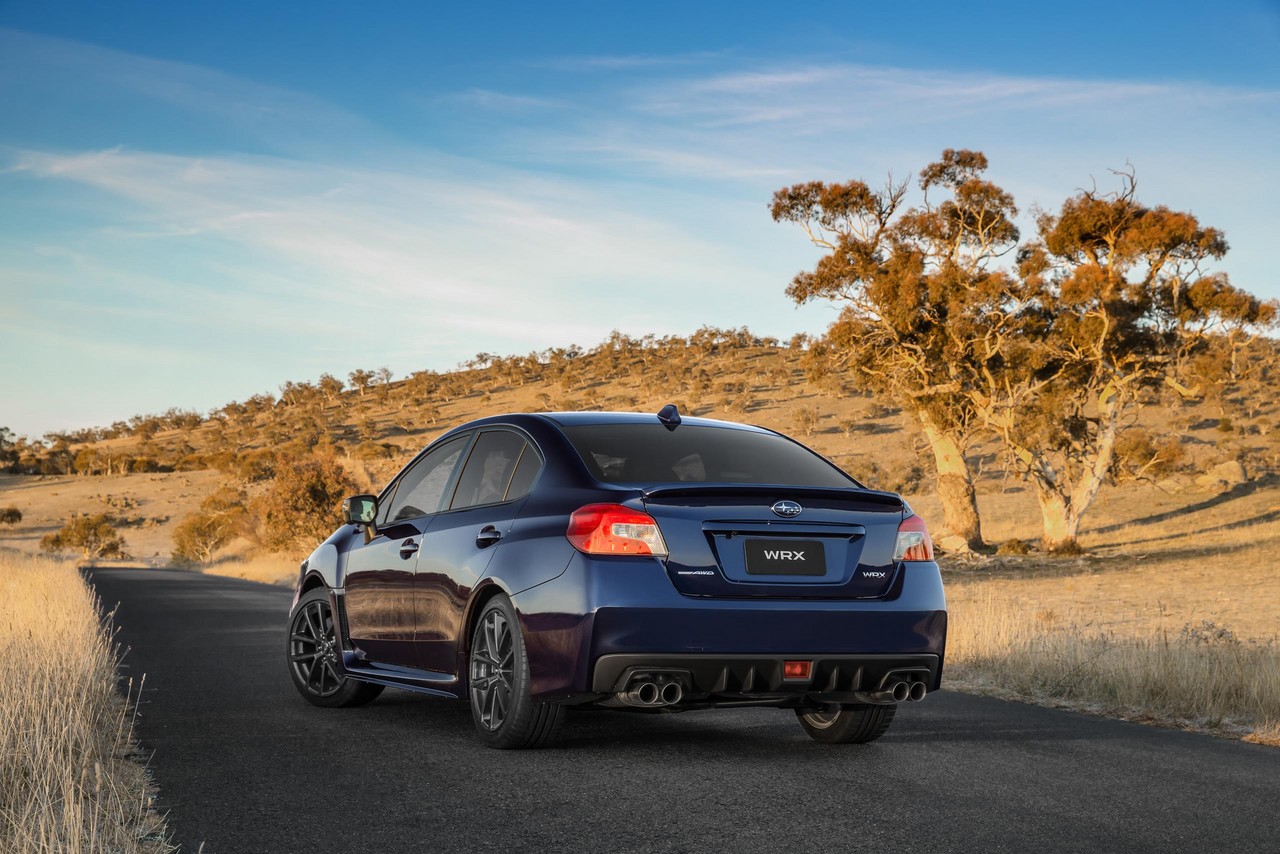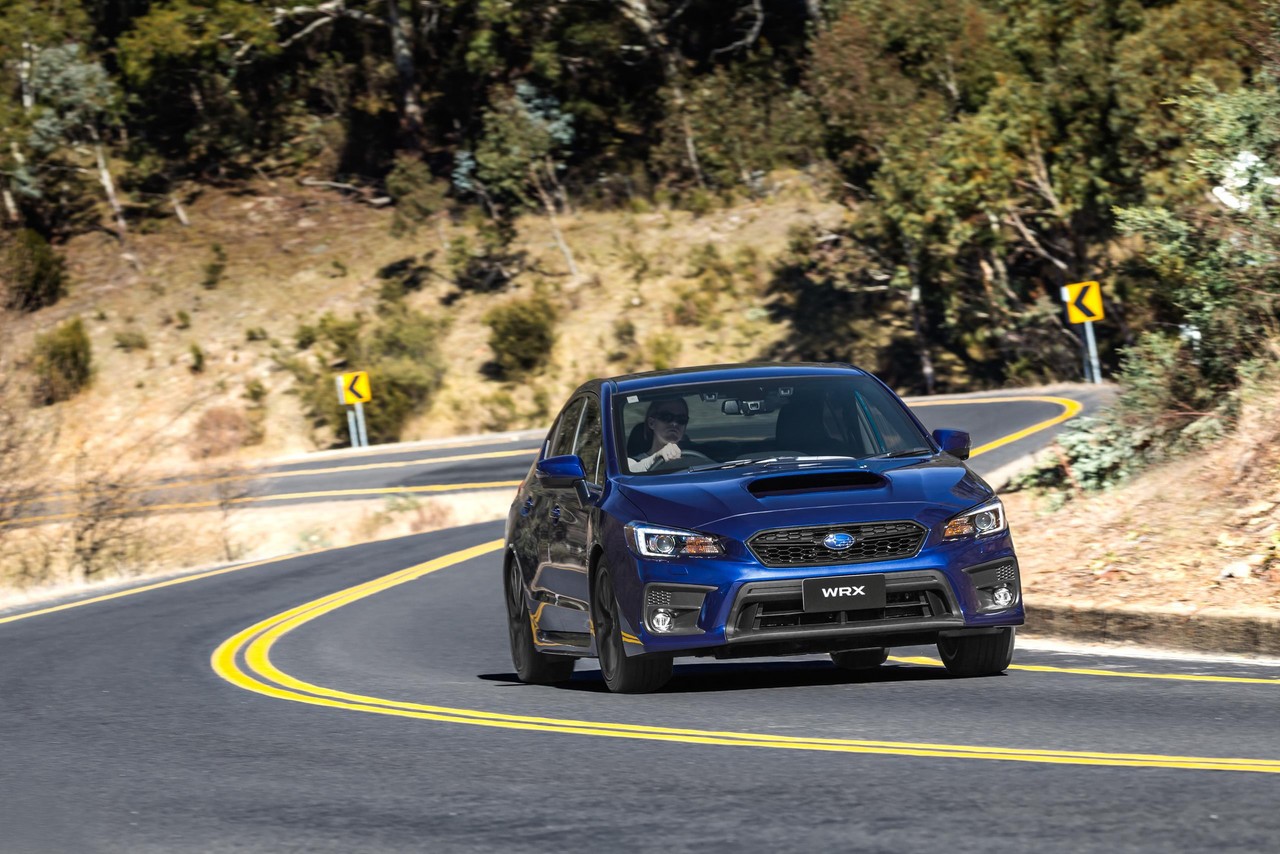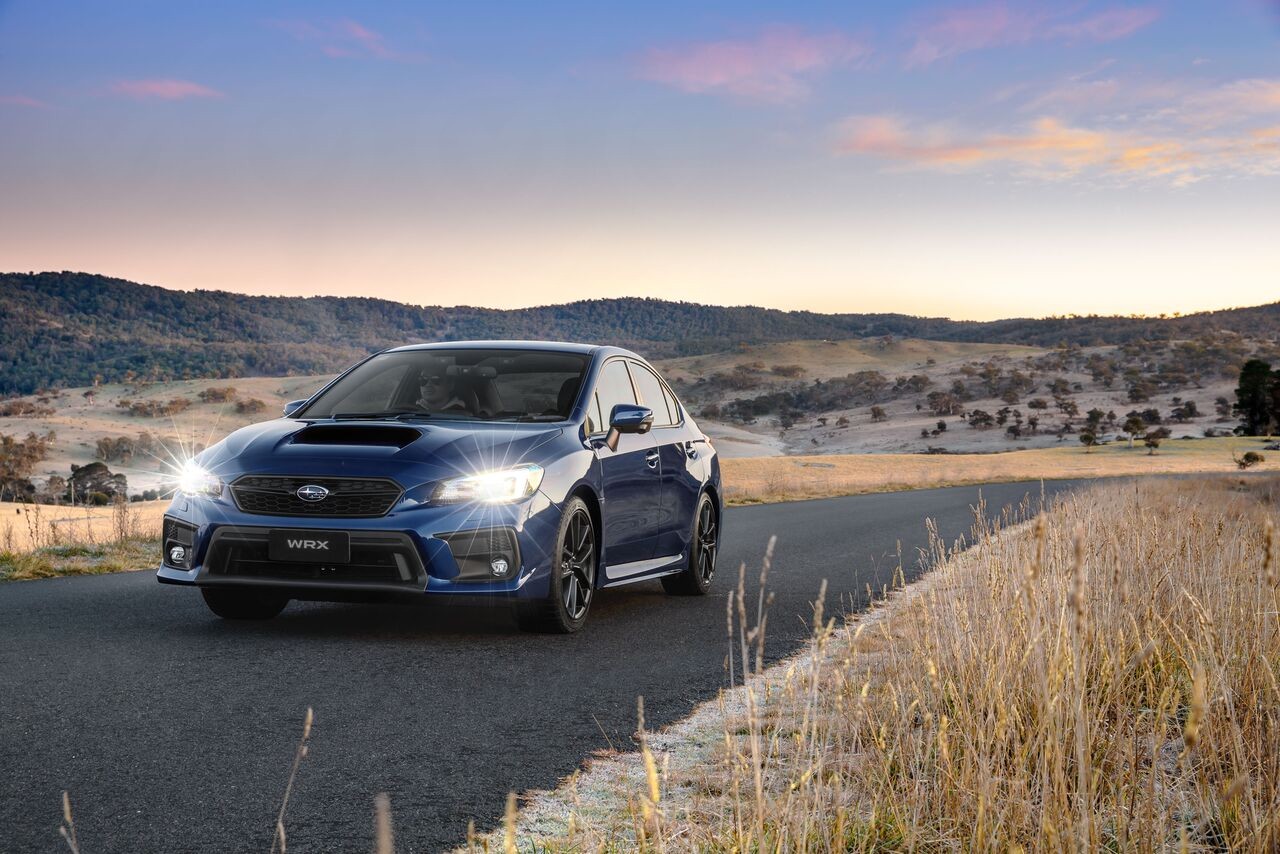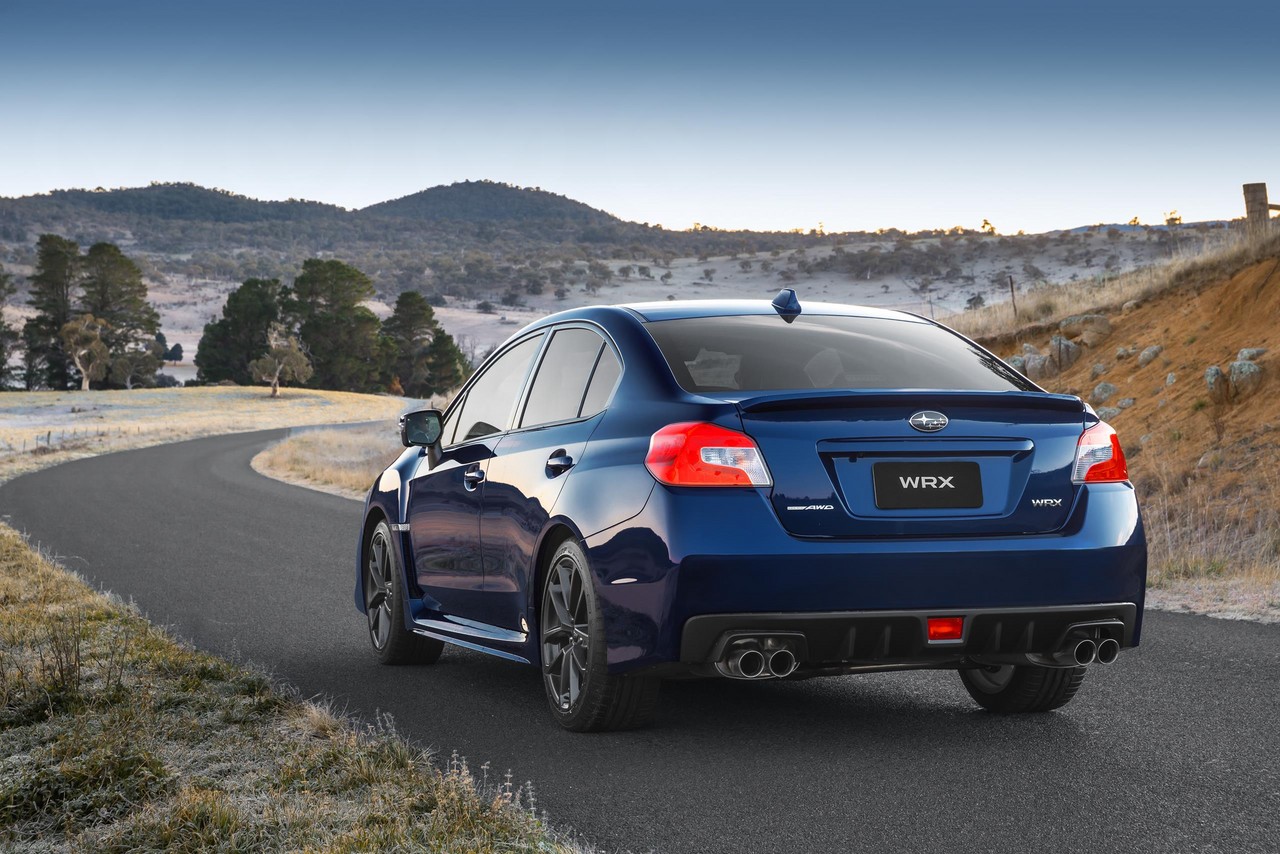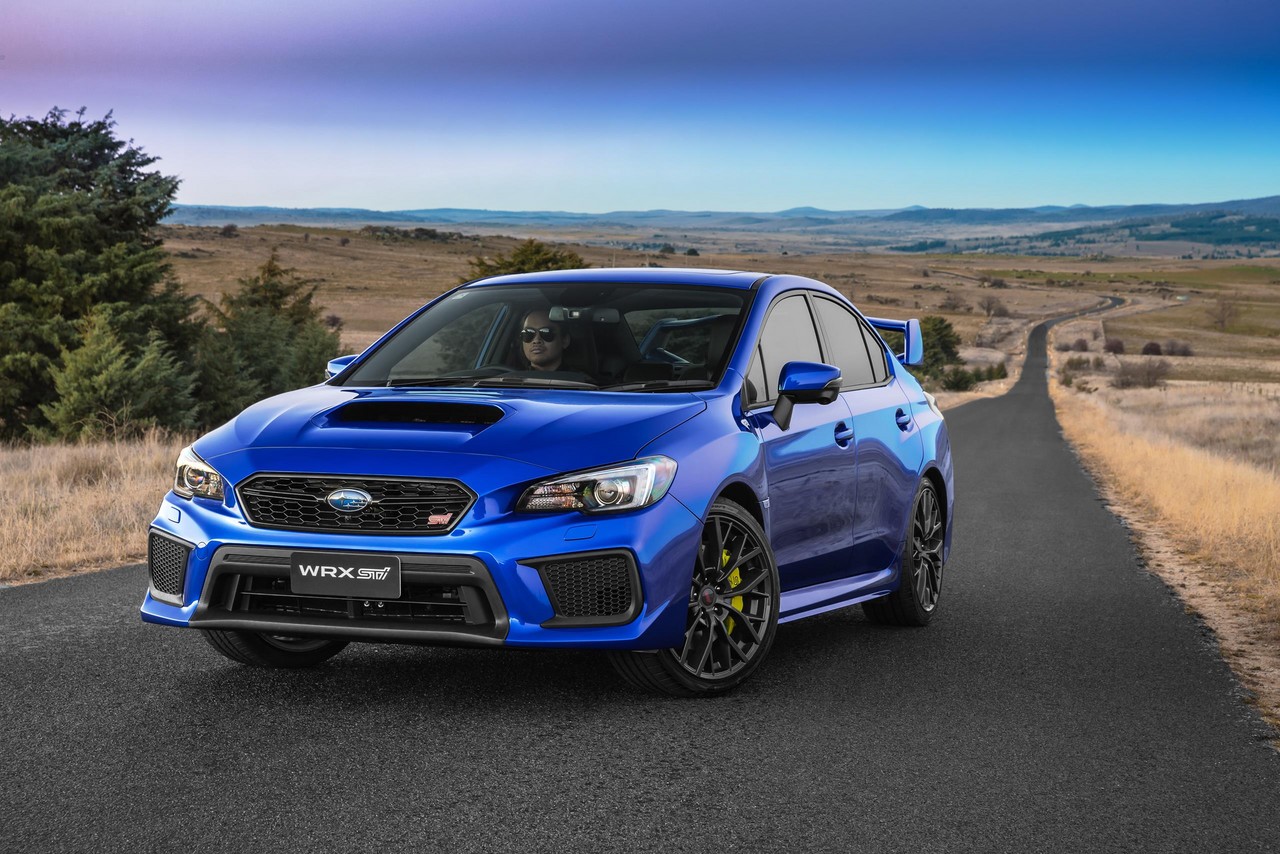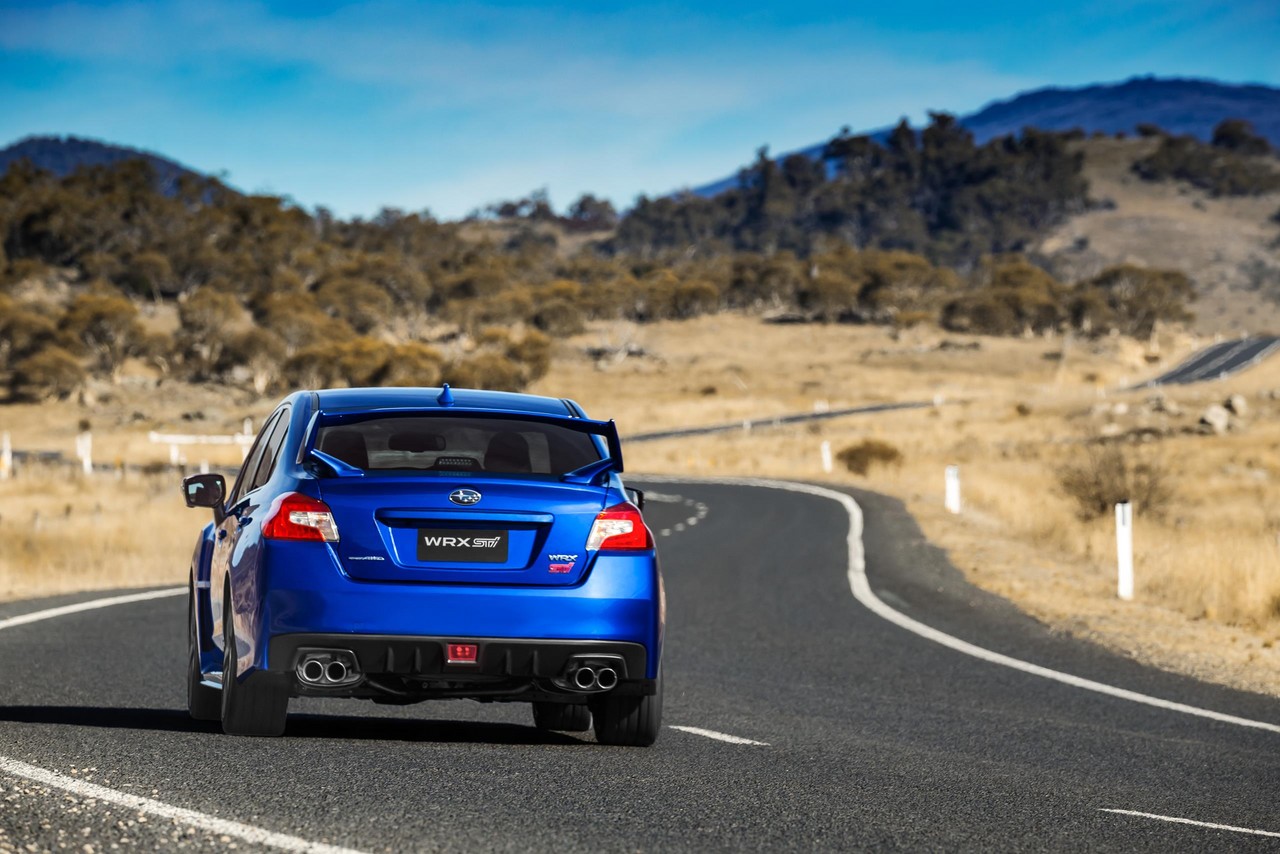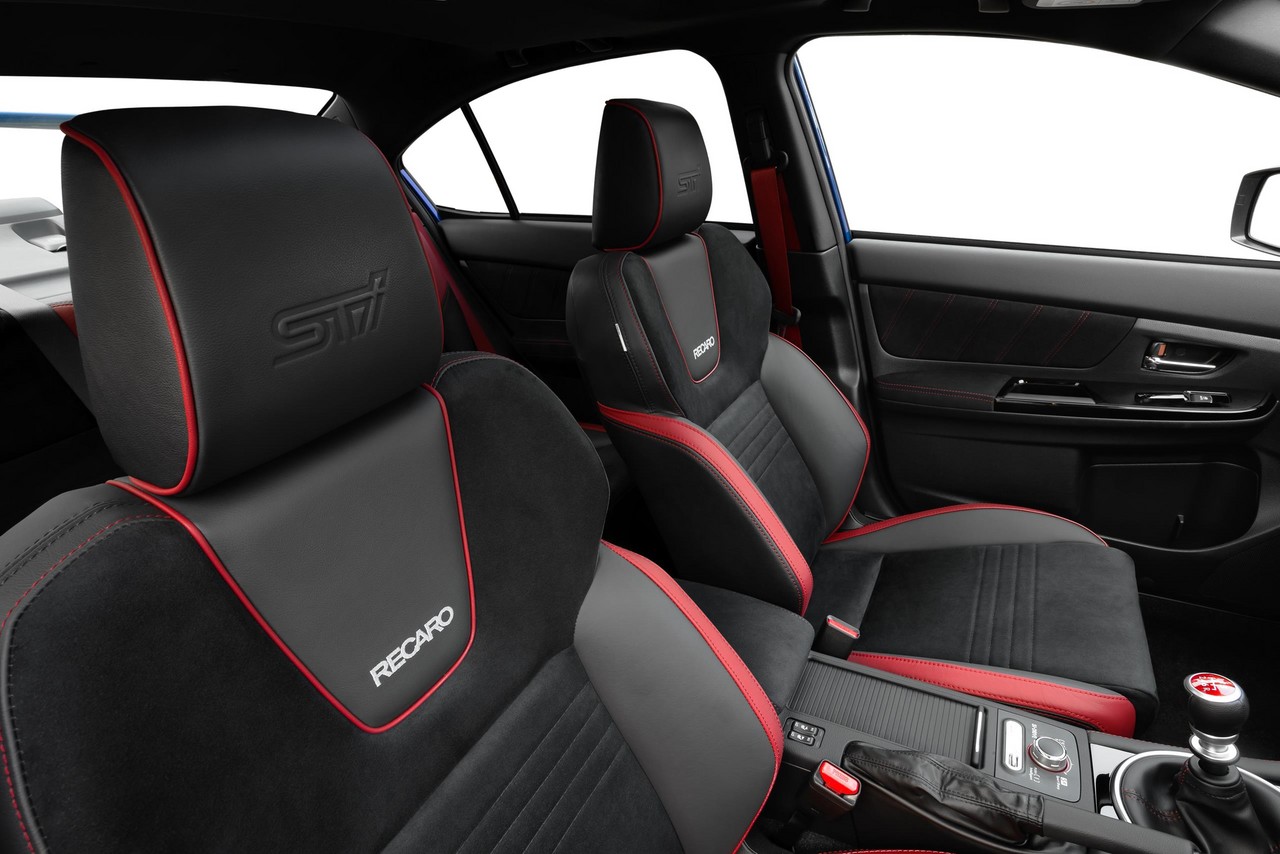
- CVT causes sluggish performance on take-off
- For WRX STi, initial turbo lag
- For WRX, seats lack support
- Tyre noise
Review: Subaru V1.I WRX and WRX STi (2014-17)
Overview
Released in Australia in March 2014, the Subaru V1 WRX was a compact, performance sedan. Manufactured in Japan, the all-wheel drive V1 WRX was powered by a 2.0-litre horizontally-opposed, turbocharged four-cylinder petrol engine that was mated to either a six-speed manual or continuously variable transmission (CVT) with steering wheel gearshift paddles. The WRX STi, however, was released in April 2014 and powered by a 2.5-litre turbocharged petrol engine that was solely available with a six-speed manual transmission.
FA20F and EJ257 engines
Of the engines,
- For the V1 WRX, the 2.0-litre FA20F engine had an open-deck aluminium block, double overhead camshafts (chain-driven), four valves per cylinder, Subaru’s Dual Active Valve Control System (AVCS, for variable intake and exhaust valve timing), a twin-scroll Garrett MGT2259S turbocharger which provided maximum boost pressure of 1.10 bar (15.9 psi), direct injection and a compression ratio of 10.6:1; and,
- For the V1 WRX STi, the 2.5-litre EJ257 engine had a semi-closed aluminium block with cast iron liners, an aluminium cylinder head, double overhead camshafts (belt-driven), four valves per cylinder, variable intake and exhaust valve timing (Subaru’s ‘Dual Active Valve Control System’ or ‘Dual AVCS’), a single-scroll IHI VF48 turbocharger (understood to provide maximum boost pressure of 14.7 psi), and a compression ratio of 8.2:1.
Transmissions
The new six-speed manual transmission had a 12 per cent shorter shift stroke than its predecessor and featured carbon syncros for the first and second gears. The CVT, however, enabled drivers to select from Intelligent, Sport and Sport Sharp drive modes which varied throttle sensitivity and gearshift behaviour. Of these,
- Intelligent: provided smooth power output and improved fuel economy, with variable shift when the accelerator position was less than 40 per cent and six-speed stepped shifting when accelerator position exceeded 40 per cent;
- Sport: increased use of higher engine speeds and had a lower accelerator position threshold of 30 per cent for variable and stepped six-speed shifting; and,
- Sport Sharp: sharper throttle response and eight-speed close-ratio stepped shifting.
| Engine | Trans. | Peak power | Peak torque | |
|---|---|---|---|---|
| WRX | 2.0-litre FA20F turbo petrol F4 | 6sp man., CVT |
197 kW at 5600 rpm | 350 Nm at 2400-5200 rpm |
| WRX STi | 2.5-litre EJ257 turbo petrol F4 | 6sp man. | 221 kW at 6000 rpm | 407 Nm at 4000 rpm |
Subaru WRX AWD systems
The Subaru WRX was available with two different all-wheel drive (AWD) systems according to transmission type:
- For WRX models with manual transmissions, the AWD system utilised a viscous limited slip centre differential. In normal conditions, the system provided a 50:50 front:rear torque split. If the front or rear wheels lost traction, however, up to 80 per cent of the engine’s torque could be directed to the opposing axle; and,
- For WRX models with continuously variable transmissions, the ‘Variable Torque Distribution’ (VTD) AWD system consisted of a planetary centre differential which operated in conjunction with an electronically-controlled continuously variable hydraulic transfer clutch. In normal conditions, the VTD system provided a 45:55 front:rear torque split, though this varied according to driving and road conditions.
The WRX was also fitted with a limited-slip Torsen rear differential as standard and also featured an Active Torque Vectoring (ATV) function which could reduce understeer by applying brake pressure to the inside front wheel when cornering.
Subaru WRX STi AWD system
The Subaru WRX STi had a ‘Multi-Mode Driver Controlled Centre Differential’ (DCCD) which used planetary-type centre differential gears with a nominal 41:59 torque split. As part of this system, a mechanical limited-slip centre differential augmented an electronically-controlled centre differential to enhance torque transfer (determined by sensor inputs for steering angle, throttle position, RPM, lateral-g, yaw, brake, ABS and wheel speed). Furthermore, a helical-type limited-slip front differential and a Torsen (torque-sensing) limited-slip rear differential enabled cross-axle torque transfers.
The DCCD AWD system had three automatic modes which provided varying degrees of centre differential lock. In manual mode, however, the driver could select from one of six centre differential locking levels.
Like the standard WRX AWD system, the WRX STi also had Active Torque Vectoring (ATV).
Body and dimensions
Compared to its GE Impreza WRX predecessor, the V1 WRX was 15 mm longer (at 4595 mm), 55 mm wider (1795 mm), the same height (1475 mm) and had a 30 mm longer wheelbase (2650 mm); boot capacity also increased by 40 litres to 460 litres. Relative to its predecessor, the base of the A-pillar was also 200 mm further forward and the increased use of high-tensile steel contributed to an approximate 40 per cent increase in torsional rigidity and 30 per cent increase in bending rigidity.
Suspension and steering
The Subaru WRX had MacPherson strut front suspension and double wishbone rear suspension. Furthermore, the WRX and WRX STi had electric power steering systems with 14.5:1 ratio and 13.0:1 ratios, respectively.
Safety equipment
Standard safety equipment for the Subaru WRX included dual front airbags, a driver’s knee airbag, front side airbags, full-length curtain airbags, ABS, electronic brake force distribution, brake assist, electronics stability control (Subaru’s Vehicle Dynamics Control, or VDC), traction control and front seatbelts with pretensioners and load limiters.
From July 2015, the Subaru WRX Premium and WRX STi Premium were fitted with Subaru’s ‘Vision Assist’ technologies which included:
- Blind Spot Detection (BSD): could detect if another vehicle was in the driver’s blind spot and, if so, illuminated an icon in the door mirror. If the driver then applied the indicators to change into that lane, the icon would flash to warn the driver;
- Lane Change Assist (LCA): could detect if a vehicle in an adjacent lane was approaching from behind and would flash the icon in the door mirror on that side of the vehicle to warn the driver;
- Rear Cross Traffic Alert: could detect oncoming vehicles that may cross the driver’s path if it were to reverse from a parking space, and warn the driver by flashing the icon in the applicable door mirror;
- High Beam Assist: could detect traffic – oncoming and travelling in the same direction as the driver – and revert to low beams to avoid dazzling other drivers;
- Side View Monitor: used a camera in the passenger side mirror and displayed that information on the multi-function display to indicate the distance from the kerb (or a parked vehicle) when reversing into a parking space;
- An auto-dimming rear view mirror; and,
- Power folding door mirrors.
Brakes
The Subaru V1 WRX had 315 mm by 24 mm ventilated front disc brakes with dual-piston calipers and 286 mm by 10 mm solid rear discs with single piston calipers. The Subaru WRX STi, however, had a Brembo braking package which consisted of 326 mm by 30 mm ventilated front disc brakes with four-piston calipers and 316 mm by 20 mm ventilated rear discs with dual-piston calipers.
ANCAP crash testing
In ANCAP crash testing , the 2014 Subaru WRX received a five star adult occupant protection rating with a score of 35.85 out of 37. In the offset crash test, protection of the front occupants’ heads and upper legs were rated as good, though chest and lower leg protection was rated as adequate (i.e. a slight risk of serious injury). Maximum points, however, were awarded in the side impact test.
Features: Subaru WRX and WRX Premium
Standard features for the Subaru WRX included 17 x 8-inch aluminium alloy wheels with 235/45 R17 94W Dunlop SP Sport Maxx RT tyres, a six speaker sound system with MP3/WMA compatibility, a CD player, auxiliary inputs (3.5 mm/USB) and Bluetooth audio streaming, Bluetooth mobile phone connectivity with voice recognition, climate control air conditioning, cruise control, LED headlights, daytime running lights, front and rear fog lights, a reversing camera, 60:40 split and folding rear seats, a leather-wrapped steering wheel and gearshift lever, remote central locking, power windows and mirrors, a height and reach adjustable steering column, a height adjustable driver’s seat, two 12 volt power sockets, illuminated vanity mirrors, rear privacy glass, a trip computer, an alarm and immobiliser.
The Subaru WRX Premium was further equipped with a harman kardon sound system which included eight speakers, a subwoofer and amplifier, a satellite navigation system with a 6.1-inch touch screen, leather upholstery, an eight-way power adjustable driver’s seat, automatic headlights, rain-sensing wipers, a power-operated sunroof, a proximity key and push-button start.
Features: Subaru WRX STi
Compared to the WRX, the Subaru WRX STi was further equipped with 18 x 8.5-inch gunmetal-finish alloy wheels with 245/40 R18 97W Dunlop SP Sport Maxx tyres, a harman kardon sound system with eight speakers, a subwoofer and amplifier, a satellite navigation system system with a 6.1-inch touch screen, dual-zone climate control air conditioning, Alcantara seat upholstery with leather trim, automatic headlights, rain-sensing wipers, a proximity key and push-button start. Although the WRX STi was fitted with a rear wing as standard, it could be removed as a no-cost option.
The Subaru WRX STi Premium was further equipped with 18-inch BBS forged cast alloy wheels, leather seats with perforated inserts, an eight-way power adjustable driver’s seat, heated front seats, heated door mirrors and a power sunroof.
July 2015 update: WRX MY16
In July 2015, standard features for the Subaru WRX were extended to include 18-inch alloy wheels and a 6.2-inch touchscreen infotainment system with pinch/zoom, voice recognition and Pandora compatibility. Furthermore, the WRX Premium and WRX STi Premium were fitted with a seven-inch touchscreen which had the same functionality.
2015 Subaru WRX and WRX STi Hyper Blue
In October 2015, Subaru released limited-run Hyper Blue Special Editions of:
- The Subaru WRX Premium with CVT (200 units); and,
- The Subaru WRX STi Premium (50 units).
The WRX Premium Hyper Blue special edition could be identified by its Hyper Blue paint finish, black BBS performance alloy wheels, black door mirrors and black badges.
Inside, the WRX Premium Hyper Blue featured custom floor mats and had blue stitching on its Alcantara seats, steering wheel, gearshift knob and boot, centre console and door trims.
Similarly, the WRX STi Premium Hyper Blue could be identified by its Hyper Blue paint finish, black alloy wheels, black door mirrors and black badges, but was also fitted with a flexible tower bar and front lip spoiler. Inside, the WRX STi Premium Hyper Blue had a short gearshift assembly, custom floor mats and blue stitching on its Alcantara seats, steering wheel, gearshift boot, centre console and door trims.
Brochures
- Brochure: Subaru V1 WRX (March 2014)
- Brochure: Subaru V1 WRX STi (April 2014)
- Brochure: Subaru V1 WRX (November 2016)
- Brochure: Subaru V1 WRX STi (November 2016)
Specifications
Related links
Review: Subaru V1.II WRX and WRX STi (2017-21)
Overview
Released in Australia in July 2017, the Subaru V1 Series II (V1.II) WRX and WRX STi introduced cosmetic and interior updates, revised suspension, ‘EyeSight’ safety technologies for WRX models with CVTs, upgraded brakes for the WRX STi and the introduction of a WRX STi spec.R model.
Visually, the Subaru V1.II WRX and WRX STi could be identified by their revised front bumpers, larger lower grilles, new fog light bezels and LED headlights with integrated indicator lights. A new design was introduced for the Subaru WRX’s 18-inch alloy wheels, while the WRX STi was fitted with 19-inch forged alloy wheels.
Inside, the Subaru V1.II WRX and WRX STi were equipped with a 5.9-inch Multi-Function Display (previously 4.3-inch), the interiors featured increased use of ‘interior decorations with a rigid, shiny black finish’, TPO (thermoplastic olefin) door handle grips and a new instrument panel with white illumination, red needles and a tinted glass covering. The WRX STi was also fitted with red seatbelts.
| Engine | Trans. | Peak power | Peak torque | |
|---|---|---|---|---|
| WRX | 2.0-litre FA20F turbo petrol F4 | 6sp man., CVT |
197 kW at 5600 rpm | 350 Nm at 2400-5200 rpm |
| WRX STi | 2.5-litre EJ257 turbo petrol F4 | 6sp man. | 221 kW at 6000 rpm | 407 Nm at 4000 rpm |
| WRX STi spec.R | 2.5-litre EJ257 turbo petrol F4 | 6sp man. | 221 kW at 6000 rpm | 407 Nm at 4000 rpm |
Suspension
For the Subaru V1.II WRX and WRX STi, changes were made to front and rear damping, spring stiffness and the rear stabiliser bar to ‘enhance control and stability, and provide better ride comfort’.
Brakes
While brake dimensions were unchanged, the Subaru V1.II WRX was fitted with Jurid performance brake pads which – according to Subaru – had superior fade resistance and improved brake efficiency by approximately 20 per cent. For the WRX, the brake callipers were painted red, though this was limited to the front brake callipers only for models with CVTs.
The Subaru WRX STi models, however, were fitted with larger brake discs (340 mm diameter at the front and 326 mm diameter at the rear) and six-piston Brembo front brake callipers (previously four-piston callipers). Furthermore, the front brake discs were cross-drilled for better heat dissipation and fade resistance and the new brake pads had a larger surface area (approximately 20 per cent larger for the front and 50 per cent larger for the rear). For the WRX STi, the brake callipers were painted yellow.
Safety equipment
For the Subaru V1.II WRX with CVT, standard safety equipment was extended to include the following ‘Vision Assist’ technologies:
- Blind Spot Monitoring;
- Lane Change Assist;
- High Beam Assist;
- Side View Monitor; and,
- Rear Cross Traffic Alert.
Beyond this, the Subaru V1.II WRX with CVT and WRX Premium with CVT were equipped with Subaru’s ‘EyeSight’ Driver Assist system which included –
- Adaptive Cruise Control (ACC): could maintain a safe distance from the vehicle ahead by braking, or accelerate up to the driver-selected target speed where safe to do so. ACC could operate at speeds up to 145 km/h and could detect illumination of the brake lights of the vehicle ahead for smoother deceleration and acceleration;
- Brake light recognition: could detect if the brake lights of the vehicle ahead were illuminated to provide earlier detection of a collision hazard;
- Vehicle Lane Departure Warning: could detect if the car began to drift outside its lane without the indicators having been activated and alert the driver;
- Lane Keep Assist (LKA): operating at speeds above 60 km/h, LKA would provide corrective steering assistance to keep the vehicle in its lane if it was about to drift outside of it;
- Lane Sway Warning: at speeds above 60 km/h, vehicle sway (or drift) was monitored and, if detected, a warning message and tone was issued. Vehicle sway could result from driver fatigue, inattentive driving or cross-winds;
- Lead Vehicle Start Alert: if an obstacle was detected in front of the vehicle, sudden movement or unintended depression of the accelerator would be restricted. A warning display and sound would also be activated;
- Pre-Collision Braking Assist: could prime the braking system for more rapid deceleration when the brake pedal was depressed or autonomous braking activated;
- Pre-Collision Braking: monitored the distance to objects ahead could detect if a collision was imminent, provided the relative speed difference of the vehicle ahead was less than 50 km/h. If detected, the brakes would be applied to avoid or minimise the severity of the collision (also known as ‘Autonomous Emergency Braking’, or AEB);
- Pre-collision Throttle Management: where there was a risk of collision with the vehicle ahead, pre-collision throttle management would reduce available acceleration; and,
- Pre-Collision Steering Assist: if there was a possibility of colliding with a car or object in front and the driver used the steering wheel to take evasive action, Pre-Collision Steering Assist could alter the stability control settings to assist the driver to avoid the collision.
The WRX STi models, however, were not available with these EyeSight technologies.
The Subaru V1.II WRX Premium, WRX STi Premium, WRX STi spec.R were equipped with Subaru’s ‘Front View Monitor’ which used a camera mounted in the centre of the grille (beneath the ‘Subaru’ badge) to produce images that could be displayed on the Multi Function Display (MFD). According to Subaru, these images could be used ‘to check for approaching vehicles or pedestrians at intersections with poor visbility, parking facing a wall, or other scenarios. It also enable[d] the driver to check for blind spots in front of the car, which could help avoid accidents at intersections.’
Unique within the range, the Subaru V1.II WRX Premium with CVT was equipped with Subaru’s ‘EyeSight Assist Monitor’ which could display warnings on the lower windscreen.
Features: Subaru WRX
For the Subaru V1.II WRX, standard features were extended to include directional LED headlights, LED daytime running, dusk-sensing headlights, rain-sensing wipers and heated door mirrors. For the V1.II WRX range, WRX models with CVTs gained:
- Subaru’s ‘EyeSight’ Driver Assist technologies (previously limited to the WRX Premium and WRX STi Premium);
- An electronic parking brake; and,
- ‘Automatic Vehicle Hold’ which automatically applied the brakes in situations such as traffic lights and road congestion so that the driver did not have to keep their foot on the brake pedal.
The Subaru WRX and WRX Premium were also fitted with LED fog lights, though these were omitted from the WRX STi models.
For the Subaru V1.II WRX Premium, standard features were extended to include power adjustable front seat lumbar support.
Features: Subaru WRX STi
For the Subaru V1.II WRX STi, standard features were extended to include 19-inch forged alloy wheels and heated door mirrors. Like the WRX Premium, the WRX STi Premium also gained power adjustable front seat lumbar support.
Features: WRX STi spec.R
Compared to the WRX STi Premium, the WRX STi spec.R had Recaro seats with ultrasuede seat trim and leather accents, though the driver’s seat for the WRX STi spec.R did not have memory settings or power adjustable lumbar support. Furthermore, the WRX STi spec.R was fitted with a rear spoiler as standard.
Specifications
Brochures
